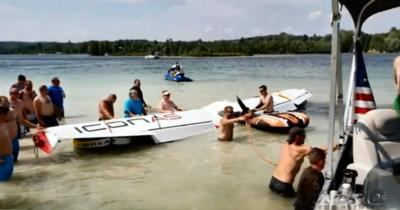Multiple Attempts At Takeoff Should Have Signaled That It Was Time To Think This Over...
The details published by the NTSB is their Preliminary Report about a July 27th Icon A5 crash contains a plethora of cautions that appear to have been ignored or gone unnoticed by the occupants of the aircraft.

At about 1220 Eastern Daylight time, the amphibious, Icon LSA, N663BA, operated by the company and a company instructor, sustained 'substantial damage during an impact with trees shortly after departure from Littlefield Lake, Lake, Michigan.' The NTSB report explains that, the "...airplane was registered to and operated by Icon Aircraft Inc. as a 14 Code of Federal Regulations Part 91 business flight when the accident occurred. The Airline Transport pilot sustained minor injuries and the pilot rated passenger sustained serious injuries."
The report's details raise a lot of questions... "According to the pilot, the purpose of the flight was a sales demonstration flight with a potential client. When he arrived at Littlefield Lake, he estimated the winds to be about 8 to 10 knots from the southwest. After landing, he taxied to the client's home and beached the airplane so the client could board. After taxing the airplane to the selected departure area, he said the wind had increased and he estimated the speed to be between 12 and 15 knots. He said when he started the takeoff run, he saw three small wakes, consistent with those from wave runners, which helped propel the airplane into the air. He said that they got into the air on the first takeoff attempt. He said the takeoff was normal and 'there was nothing wrong with the [air]plane at all.' He stated that they got to the shoreline, they were treetop height plus an estimated 50-60ft. His plan was to execute a left turn to stay over the lake in the event of an engine failure. Before
starting the right turn, he looked at the angle of attack indicator and it showed one needle width below the top of the green, and he estimated his speed between 55-60 knots. He started to initiate a 10° turn to the right to stay over the lake and it suddenly sounded like they 'hit a wall.'

The pilot rated passenger, who was seated in the left seat at the time of the accident, stated that 'the weather was not the best' and that the wind was shifting 180°. He said he told the pilot-in-command (PIC) this sentiment, and that it took four takeoff attempts to get airborne. After the second attempt, he said he told the PIC that it would not break his heart if they did not go. He said that the airplane felt very sluggish and acted as if it did not want to come off the water. When they did get airborne, they were about 100 ft from the trees, headed straight toward them and the airplane 'felt very heavy.' When asked to elaborate on the weight, he said the PIC told him they had 485 lbs available and only ¾ of a tank of fuel."
Further details show that, "A post-accident weight and balance calculation, based upon the most recent available weight and balance and information provided to a Federal Aviation Administration aviation safety inspector by the PIC, revealed that the airplane was about 70 lbs over max gross weight and outside of the weight and center of gravity envelope limits contained within Pilot's Operating Handbook.
A review of video of the accident flight shows the airplane in a nose-high attitude with the flaps extended as it approaches trees after takeoff. As the airplane reached about the midpoint of a stand of trees, the angle of attack appears to increase and the nose drops. The right wing then lowered and impacted one of the trees. The airplane subsequently descend rapidly into the water.
A witness to the accident stated that they saw the airplane make three takeoff attempts before the airplane became airborne."
Ouch...
E-I-C Note: This is NOT the first time that an Icon A5 has gone down with a factory pilot aboard, though this time both survived... and with the known issues with its limited payload and meager performance in maxed out conditions, one wonders why there were so many attempts at a takeoff when the airplane clearly wasn't having any of it. The aircraft's performance is now being called into question after a number of incidents, and while we can't really ascertain for certain, why these issues are being brought up so often, we sure wish the management of the company would quit avoiding a critique from journalists who are known for calling out issues when they find them, because the airplane would have a hard time proving its earning the horrific rep its getting. Several years ago, we made a pitch for a comprehensive review of the aircraft using a means to extensively document our findings and evaluations... but the company still seems scared of an honest review, no matter how well
detailed it may be--or maybe that's the problem. --Jim Campbell, ANN E-I-C.
 ANN's Daily Aero-Term (04.24.24): Runway Lead-in Light System
ANN's Daily Aero-Term (04.24.24): Runway Lead-in Light System ANN's Daily Aero-Linx (04.24.24)
ANN's Daily Aero-Linx (04.24.24) Aero-FAQ: Dave Juwel's Aviation Marketing Stories -- ITBOA BNITBOB
Aero-FAQ: Dave Juwel's Aviation Marketing Stories -- ITBOA BNITBOB Classic Aero-TV: Best Seat in The House -- 'Inside' The AeroShell Aerobatic Team
Classic Aero-TV: Best Seat in The House -- 'Inside' The AeroShell Aerobatic Team Airborne Affordable Flyers 04.18.24: CarbonCub UL, Fisher, Affordable Flyer Expo
Airborne Affordable Flyers 04.18.24: CarbonCub UL, Fisher, Affordable Flyer Expo



